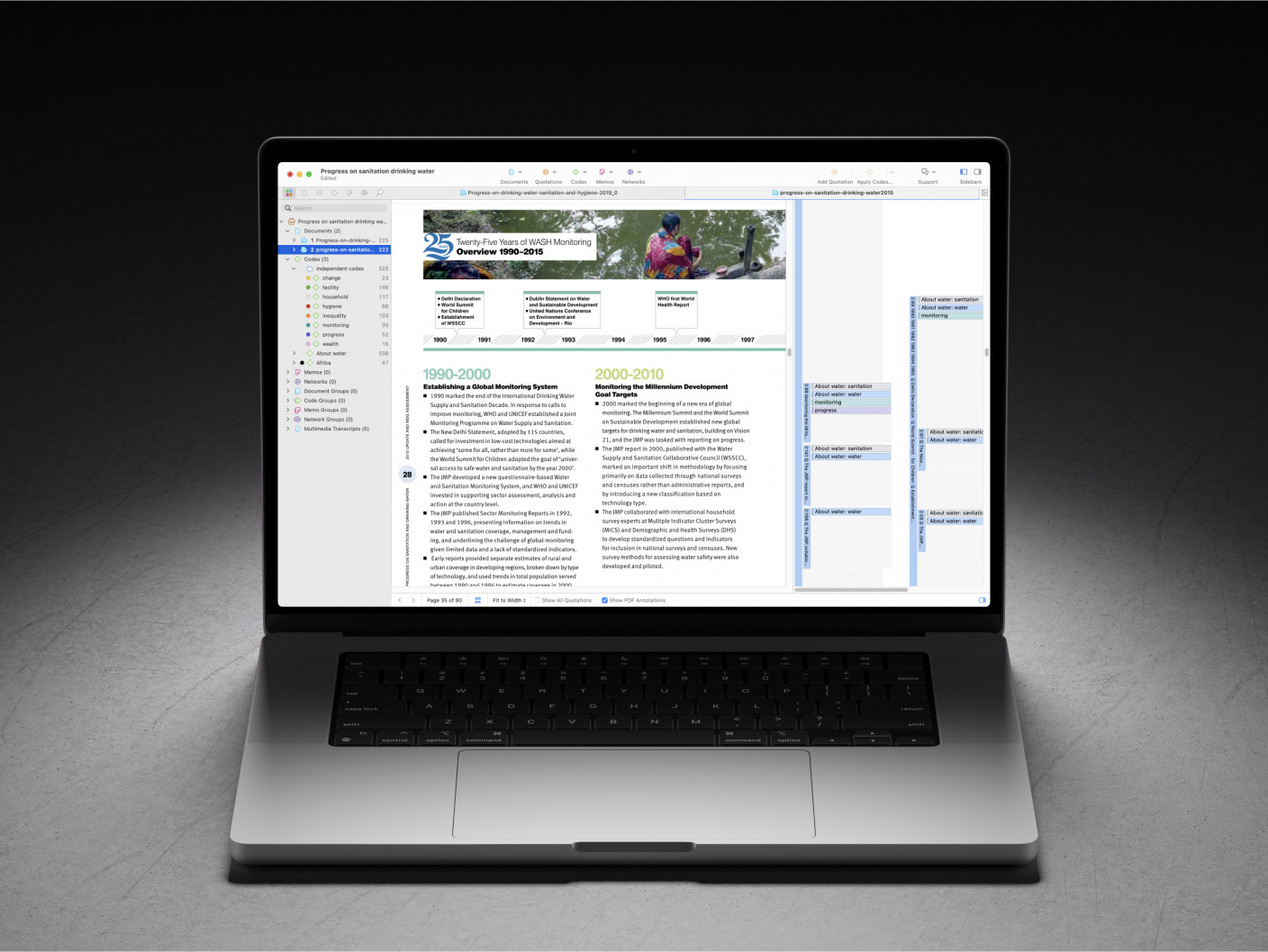- Introduction and overview
- What is qualitative research?
- What is qualitative data?
- Examples of qualitative data
- Qualitative vs. quantitative research
- Mixed methods
- Qualitative research preparation
- Theoretical perspective
- Theoretical framework
- Literature reviews
- Research question
- Conceptual framework
- Conceptual vs. theoretical framework
- Data collection
- Qualitative research methods
- Interviews
- Focus groups
- Observational research
- Case studies
- Surveys
- Ethnographical research
- Ethical considerations
- Confidentiality and privacy
- Bias
- Power dynamics
- Reflexivity
- How to cite "The Ultimate Guide to Qualitative Research - Part 1: The Basics"
Observational research
Observational research is a social research technique that involves the direct observation of phenomena in their natural setting.
An observational study is a non-experimental method to examine how research participants behave. Observational research is typically associated with qualitative methods, where the data ultimately require some reorganization and analysis.

What is observational research?
Contemporary research is often associated with controlled experiments or randomized controlled trials, which involve testing or developing a theory in a controlled setting. Such an approach is appropriate for many physical and material sciences that rely on objective concepts such as the melting point of substances or the mass of objects. On the other hand, observational studies help capture socially constructed or subjective phenomena whose fundamental essence might change when taken out of their natural setting.
What is an example of observational research?
For example, imagine a study where you want to understand the actions and behaviors of single parents taking care of children. A controlled experiment might prove challenging, given the possibility that the behaviors of parents and their children will change if you isolate them in a lab or an otherwise unfamiliar context.
Instead, researchers pursuing such inquiries can observe participants in their natural environment, collecting data on what people do, say, and behave in interaction with others. Non-experimental research methods like observation are less about testing theories than learning something new to contribute to theories.
Uses for observational research
The goal of the observational study is to collect data about what people do and say. Observational data is helpful in several fields:
- market research
- health services research
- educational research
- user research
Observational studies are valuable in any domain where researchers want to learn about people's actions and behaviors in a natural setting. For example, observational studies in market research might seek out information about the target market of a product or service by identifying the needs or problems of prospective consumers. In medical contexts, observers might be interested in how patients cope with a particular medical treatment or interact with doctors and nurses under certain conditions.

Observations in research
Researchers may still be hung up on science being all about experiments to the point where they may overlook the empirical contribution that observations bring to research and theory. With that in mind, let's look at the strengths and weaknesses of observations in research.
Strengths of observational research
Observational research, especially those conducted in natural settings, can generate more insightful knowledge about social processes or rituals that one cannot fully understand by reading a plain-text description in a book or an online resource. Think about a cookbook with recipes, then think about a series of videos showing a cook making the same recipes. Both are informative, but the videos are often easier to understand as the cook can describe the recipe and show how to follow the steps at the same time. When you can observe what is happening, you can emulate the process for yourself.
Observing also allows researchers to create rich data about phenomena that cannot be explained through numbers. The quality of a theatrical performance, for example, cannot easily be reduced to a set of numbers. Qualitatively, a researcher can analyze aspects gleaned from observing that performance and create a working theory about the quality of that performance. Through data analysis, the researcher can identify patterns related to the aesthetics and creativity of the performance to provide a framework to judge the quality of other performances.
Weaknesses of observational research
Science is about organizing knowledge for the purposes of identifying the aspects of a concept or of determining cause-and-effect relationships between different phenomena. Experiments look to empirically accomplish these tasks by controlling certain variables to determine how other variables change under changing conditions. Those conducting observational research, on the other hand, exert no such control, which makes replication by other researchers difficult or even impossible when observing dynamic environments.
The different types of observational research
Observational studies take on various forms. There are various types of observational research, each of which has strengths and weaknesses. These types are organized below by the extent to which an experimenter intrudes upon or controls the environment.
Naturalistic observation
Naturalistic observation refers to a method where researchers study participants in their natural environment without manipulating variables or intervening in any way. It provides a realistic snapshot of behavior as it occurs in real-life settings, thereby enhancing ecological validity.

Examples of naturalistic observation include people-watching in public places, observing animal behaviors in the wild, and longitudinally studying children's social development at school. This method can reveal insights about behavior and relationships that might not surface in experimental designs, such as patterns of social interaction, routines, or responses to environmental changes.
Participant observation
Participant observation is similar to naturalistic observation, except that the researcher is part of the natural environment they are observing. In such studies, the researcher is also interested in rituals or cultural practices where they can only determine their value by actually experiencing them firsthand. For example, any individual can understand the basic rules of baseball by watching a game or following a team. Participant observation, on the other hand, allows for direct participation to develop a better sense of team dynamics and relationships among fellow players.

Most commonly, this process involves the researcher inserting themselves into a group to observe behavior that otherwise would not be accessible by observing from afar. Participant observation can capture rich data from the interactions with those who are observed to the reflections of the researchers themselves.
Controlled observation
A more structured observation involves capturing the behaviors of research participants in an isolated environment. Case-control studies have a greater resemblance to experimental research while still relying on observational research methods. Researchers may utilize a case-control study when they want to establish the causation of a particular phenomenon.

For example, a researcher may want to establish a structured observation of a control group and an experimental group, each with randomly assigned research participants, to observe the effects of variables such as distractions on people completing a particular task. By subjecting the experimental group to distractions such as noise and lights, researchers can observe the time it takes participants to complete a task and determine causation accordingly.
Longitudinal study
Among the different types of observational research, this observational method is quite arduous and time-consuming as it requires observation of people or events over extended periods. Researchers should consider longitudinal observations when their inquiry involves variables that can only be observed over time. After all, variables such as literacy development or weight loss cannot be fully captured in any particular moment of observation. Longitudinal studies keep track of the same research participants or events through multiple observations to document changes to or patterns in behavior.
A cohort study is a specific type of longitudinal study where researchers observe participants with similar traits (e.g., a similar risk factor or biological characteristic). Cohort studies aim to observe multiple participants over time to identify a relationship between observed phenomena and a common characteristic.
All forms of observational or field research benefit extensively from the special capabilities of qualitative research tools like ATLAS.ti. Our software can accommodate the major forms of data, such as text, audio, video, and images. The ATLAS.ti platform can help you organize all your observations, whatever method you employ.
Conducting observational studies
Like any other study design, observational studies begin by posing research questions. Inquiries common when employing observational methods include the study of different cultures, interactions between people from different communities, or people in particular circumstances warranting further study (e.g., people coping with a rare disease).
Generally, a research question that seeks to learn more about a relatively unfamiliar phenomenon would be best suited for observational research. On the other hand, quantitative methods or experimental research methods may be more suitable for inquiries where the theory about a social phenomenon is fairly established.
Study design
Study design for observational research involves thinking about who to observe, where they should be observed, and what the researcher should look for during observation. Many events can occur in a natural, dynamic environment in a short period, so it is challenging to document everything. If the researcher knows what they want to observe, they can pursue a structured observation which involves taking notes on a limited set of phenomena.
Data collection
The actual data collection for an observational study can take several forms. Note-taking is common in observational research, where the researcher writes down what they see during the course of their observation. The goal of this method is to provide a record of the events that are observed to determine patterns and themes useful for theoretical development.

Observation can also involve taking pictures or recording audio for a richer understanding of social phenomena. Video recorded from observations can also provide data that the researcher can use to document the facial expressions, gestures, and other body language of research participants.
Note that there are ethical considerations when conducting observational research. Researchers should respect the privacy and confidentiality of their research participants to ensure they are not adversely affected by the research. Researchers should obtain informed consent from participants before any observation where possible.
Uses with other methods
Observational studies can be supplemented with other methods to further contextualize the research inquiry. Researchers can conduct interviews or focus groups with research participants to gather data about what they recall about their actions and behaviors in a natural setting. Focus groups, in particular, provide further opportunities to observe participants interacting with each other. In both cases, these research methods are ideal where the researcher needs to follow up with research participants about the evidence they've collected regarding their behaviors or actions.
Challenges of observational studies
As with many other methods in qualitative research, conducting an observational study is time-consuming. While experimental methods can quickly generate data, observational research relies on documenting events and interactions in detail that can be analyzed for theoretical development.
Unstructured data
One common critique of observational research is that it lacks the structure inherent to experimental research, which has concepts such as selection bias and interrater reliability to ensure research quality. On the other hand, qualitative research relies on the assumption that the study and its data are presented transparently and honestly. Under this principle, researchers are responsible for convincing their audiences that the assertions they make are connected empirically to the observations they have made and the data they have collected.
Researcher bias
In most qualitative research, but especially in observational research, the most important data collection instrument is the researcher themselves. This raises issues of bias and subjectivity influencing the collection and interpretation of the data.

Later in this guide, there will be discussion of reflexivity, a concept where the researcher comprehensively accounts for their place in the research relative to others in the environment. For now, it's important to know that social science researchers can and do adequately address critiques of researcher bias to maintain the empirical nature of their observational research.



